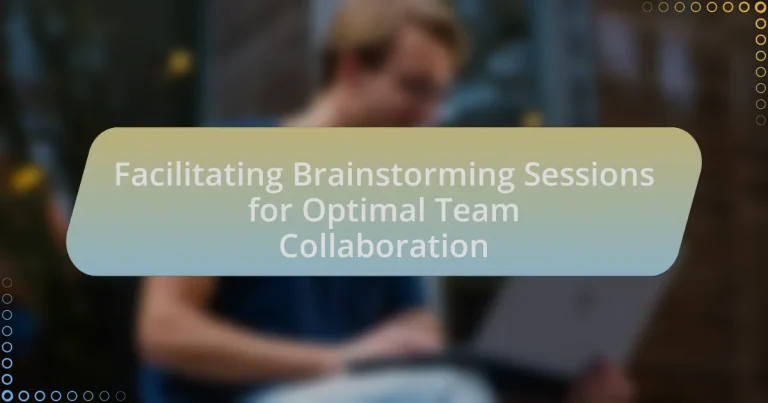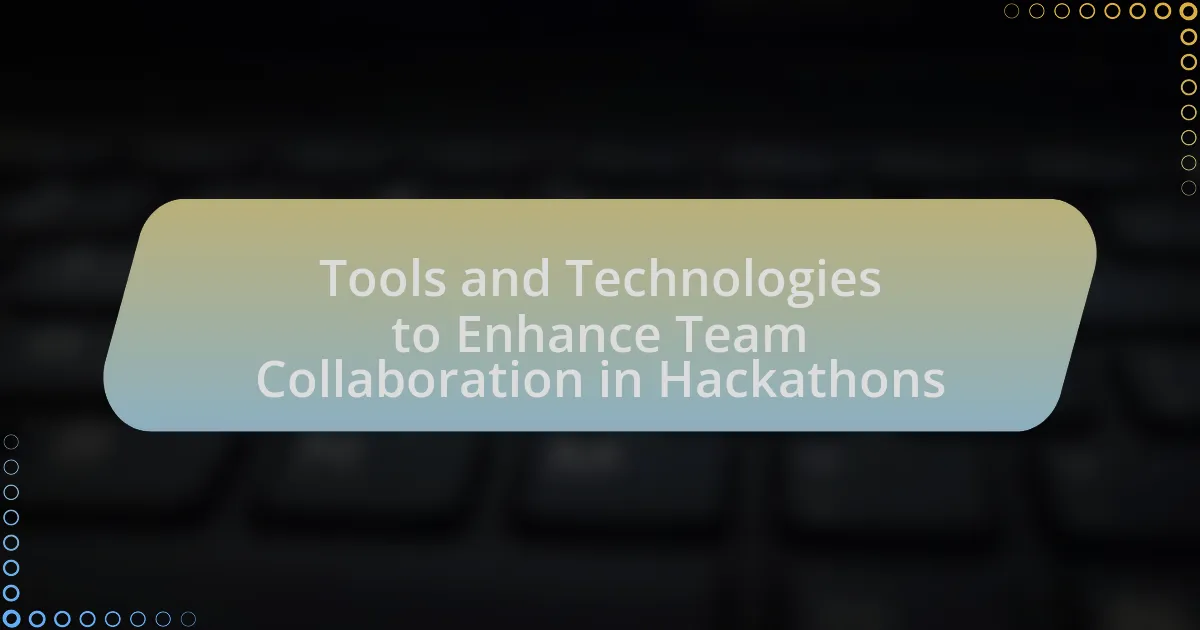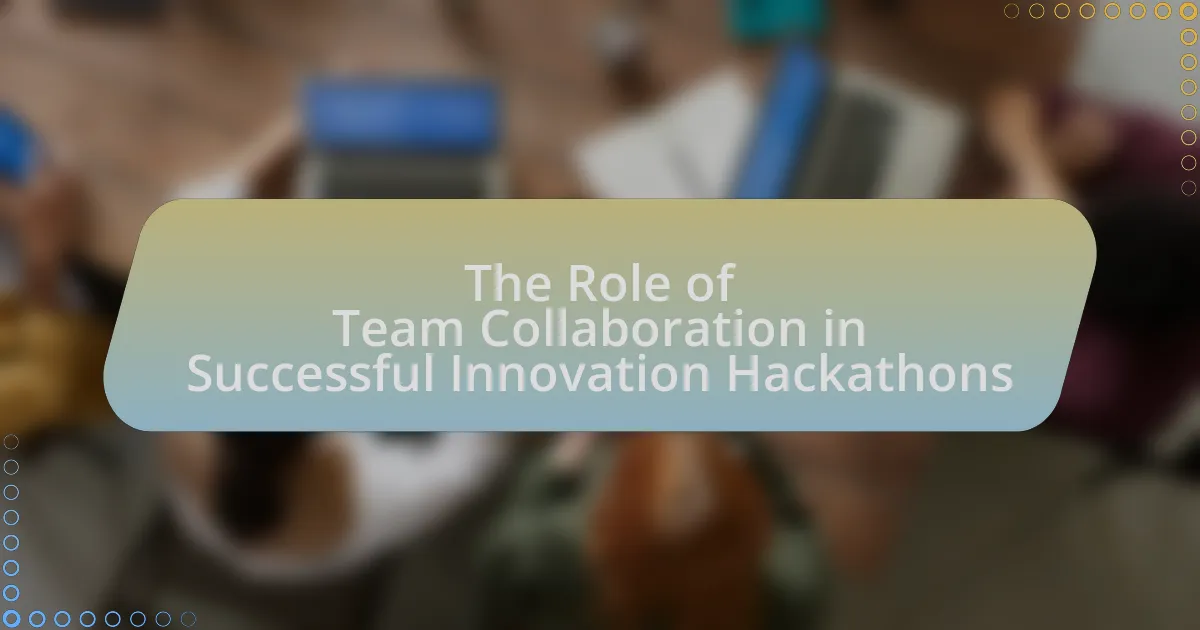The article focuses on facilitating brainstorming sessions to enhance team collaboration. It outlines key elements such as creating a safe environment, setting clear objectives, encouraging diverse perspectives, and employing structured techniques like mind mapping. The article defines success in brainstorming by the quantity and quality of ideas generated, and it discusses the roles of participants, the responsibilities of facilitators, and methods to ensure all voices are heard. Additionally, it addresses the impact of the physical and virtual environments on brainstorming effectiveness, common challenges faced, and strategies for follow-up and continuous improvement in future sessions.
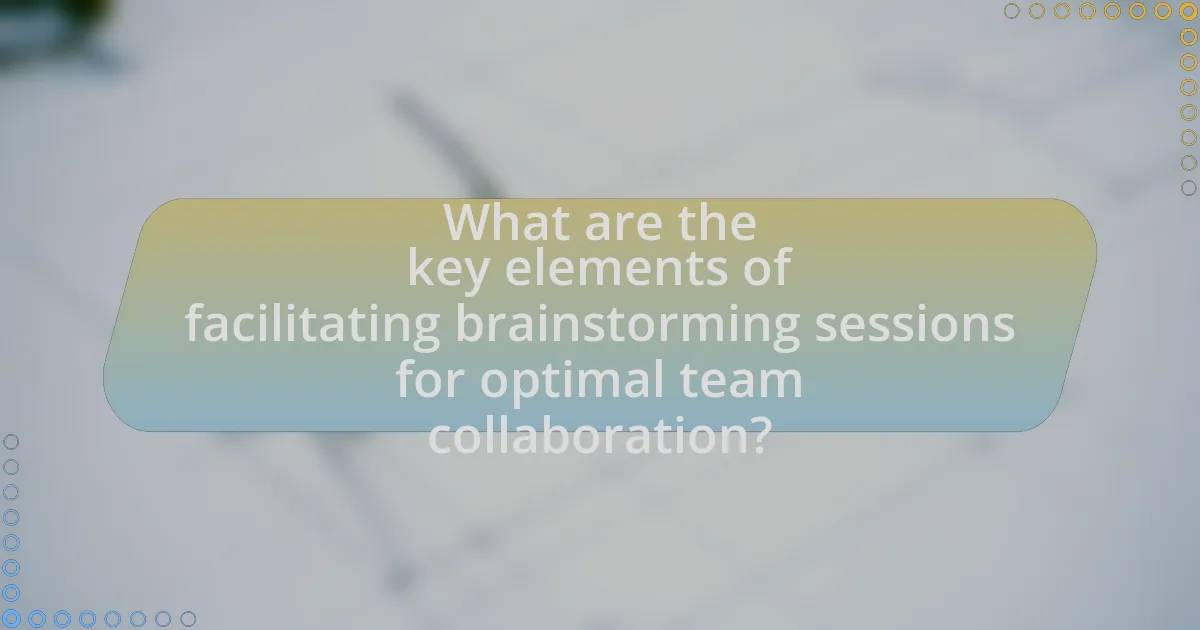
What are the key elements of facilitating brainstorming sessions for optimal team collaboration?
The key elements of facilitating brainstorming sessions for optimal team collaboration include creating a safe environment, setting clear objectives, encouraging diverse perspectives, and utilizing structured techniques. A safe environment fosters open communication, allowing team members to share ideas without fear of criticism. Clear objectives guide the session, ensuring that discussions remain focused and productive. Encouraging diverse perspectives enhances creativity, as varied backgrounds and experiences contribute to a broader range of ideas. Structured techniques, such as mind mapping or the nominal group technique, provide frameworks that help organize thoughts and prioritize contributions effectively. These elements collectively enhance collaboration and lead to more innovative solutions.
How do you define a successful brainstorming session?
A successful brainstorming session is defined by the generation of a diverse range of ideas that are relevant to the problem at hand, fostering creativity and collaboration among participants. This outcome is achieved when all team members feel encouraged to contribute without judgment, leading to a higher quantity and quality of ideas. Research indicates that sessions that incorporate techniques such as mind mapping or round-robin sharing can enhance participation and idea generation, as evidenced by a study published in the Journal of Creative Behavior, which found that structured brainstorming methods can increase idea output by up to 30%.
What criteria determine the success of a brainstorming session?
The success of a brainstorming session is determined by criteria such as the diversity of participants, the clarity of the session’s objectives, the facilitation techniques employed, and the environment in which the session takes place. Diverse participants bring varied perspectives, enhancing creativity and idea generation. Clear objectives guide the discussion and keep participants focused, while effective facilitation techniques, such as encouraging open dialogue and managing group dynamics, foster a collaborative atmosphere. Additionally, a conducive environment, free from distractions and equipped with necessary resources, supports productive brainstorming. Research indicates that sessions with diverse teams can produce 60% more ideas than homogeneous groups, highlighting the importance of participant diversity in achieving successful outcomes.
How can success be measured in team collaboration during brainstorming?
Success in team collaboration during brainstorming can be measured by the quantity and quality of ideas generated, as well as the level of participation from team members. High levels of idea generation indicate effective collaboration, while diverse and innovative ideas reflect the team’s ability to build on each other’s contributions. Research shows that teams that encourage open communication and equal participation produce 20% more ideas than those with hierarchical structures, demonstrating that inclusivity enhances brainstorming outcomes. Additionally, post-session surveys assessing team members’ satisfaction and perceived value of contributions can provide insights into the collaborative process’s effectiveness.
What roles do participants play in brainstorming sessions?
Participants in brainstorming sessions typically assume roles such as facilitator, contributor, critic, and note-taker. The facilitator guides the session, ensuring that the discussion remains focused and productive. Contributors generate ideas and share insights, while critics evaluate the feasibility and relevance of those ideas. The note-taker documents the ideas and discussions for future reference. These roles are essential for fostering a collaborative environment, as they help balance creativity with structure, ultimately leading to more effective outcomes in team collaboration.
How can different roles enhance the brainstorming process?
Different roles can enhance the brainstorming process by bringing diverse perspectives and expertise, which fosters creativity and innovation. For instance, a facilitator guides the session, ensuring that all voices are heard and that the discussion remains focused. A subject matter expert contributes specialized knowledge that can inform and refine ideas, while a creative thinker generates unconventional solutions that challenge the status quo. Research indicates that teams with varied roles are more effective in problem-solving, as they leverage their unique strengths to build on each other’s ideas, leading to more comprehensive and innovative outcomes.
What are the responsibilities of a facilitator during a session?
A facilitator during a session is responsible for guiding discussions, ensuring participation, and managing the flow of the session. The facilitator sets the agenda, establishes ground rules, and creates a safe environment for all participants to share ideas. They actively listen, encourage contributions from all members, and help to clarify points of confusion. Additionally, the facilitator synthesizes information, keeps the group focused on objectives, and ensures that time is managed effectively. These responsibilities are crucial for fostering collaboration and achieving productive outcomes in brainstorming sessions.
What techniques can be employed to encourage participation?
To encourage participation in brainstorming sessions, techniques such as creating a safe environment, using structured activities, and implementing incentives can be employed. A safe environment fosters open communication, allowing team members to share ideas without fear of criticism. Structured activities, like round-robin sharing or mind mapping, provide clear frameworks that guide participation and ensure everyone contributes. Additionally, offering incentives, such as recognition or rewards for contributions, can motivate team members to engage actively. Research indicates that teams with clear structures and supportive atmospheres see a 30% increase in participation rates compared to unstructured sessions.
How can icebreakers improve team dynamics before brainstorming?
Icebreakers can improve team dynamics before brainstorming by fostering trust and encouraging open communication among team members. When participants engage in icebreaker activities, they become more comfortable with one another, which reduces anxiety and promotes a collaborative atmosphere. Research indicates that teams with strong interpersonal relationships are 50% more effective in generating creative ideas compared to those with weaker connections. This enhanced comfort level allows individuals to share their thoughts freely, leading to a more productive brainstorming session.
What methods can be used to ensure all voices are heard?
To ensure all voices are heard during brainstorming sessions, implementing structured techniques such as round-robin sharing, anonymous feedback tools, and active facilitation is essential. Round-robin sharing allows each participant to contribute in turn, preventing dominant voices from overshadowing quieter ones. Anonymous feedback tools, like digital surveys or suggestion boxes, encourage individuals to express their ideas without fear of judgment, fostering a more inclusive environment. Active facilitation involves guiding discussions, prompting quieter members to share their thoughts, and ensuring that all contributions are acknowledged. Research indicates that diverse input leads to more innovative solutions, highlighting the importance of inclusive practices in team collaboration.
How can the environment impact brainstorming sessions?
The environment can significantly impact brainstorming sessions by influencing creativity, collaboration, and overall productivity. A well-designed space that promotes comfort and minimizes distractions can enhance participants’ ability to generate ideas. For instance, research by the University of Exeter found that office environments with natural elements, such as plants and natural light, can increase creativity by up to 15%. Additionally, collaborative spaces that encourage open communication and interaction foster a sense of community, leading to more effective brainstorming outcomes. Therefore, the physical and psychological aspects of the environment play a crucial role in shaping the effectiveness of brainstorming sessions.
What physical space considerations should be made for effective brainstorming?
Effective brainstorming requires a physical space that promotes creativity and collaboration. Key considerations include ample space for movement, comfortable seating arrangements, and access to tools like whiteboards or sticky notes. Research indicates that environments with natural light and minimal distractions enhance cognitive function and idea generation. For instance, a study by the University of Exeter found that well-designed workspaces can increase productivity by up to 15%. Additionally, flexible seating arrangements encourage interaction and engagement among team members, fostering a more dynamic brainstorming process.
How does the virtual environment differ from in-person sessions?
The virtual environment differs from in-person sessions primarily in the mode of interaction and engagement. In virtual settings, communication relies on digital tools, which can limit non-verbal cues and spontaneous interactions that are prevalent in face-to-face meetings. Research indicates that virtual meetings often lead to reduced engagement levels, as participants may experience distractions from their surroundings or multitask during sessions, impacting the overall effectiveness of collaboration. A study by the Harvard Business Review found that remote teams can struggle with building trust and rapport compared to in-person teams, which can hinder brainstorming effectiveness.
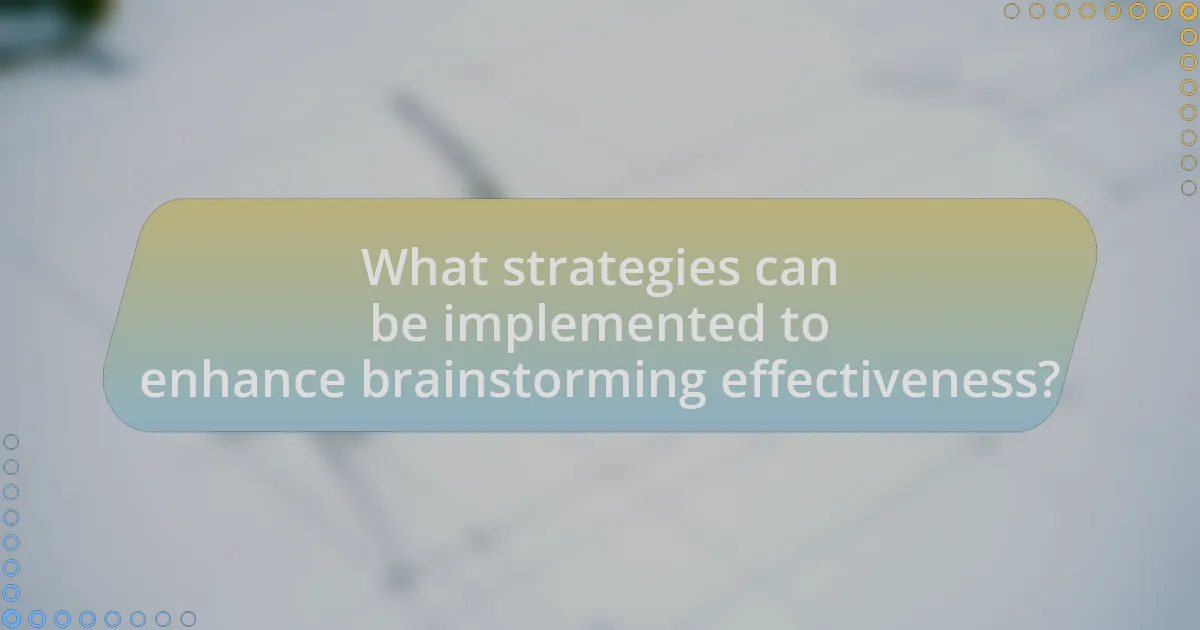
What strategies can be implemented to enhance brainstorming effectiveness?
To enhance brainstorming effectiveness, implement strategies such as setting clear objectives, encouraging diverse perspectives, and utilizing structured techniques like mind mapping. Clear objectives guide participants on the focus of the session, ensuring that discussions remain relevant and productive. Encouraging diverse perspectives fosters creativity and innovation, as varied backgrounds and experiences contribute unique ideas. Structured techniques, such as mind mapping, help organize thoughts visually, making it easier to explore connections between ideas. Research indicates that teams employing these strategies can generate 20% more ideas compared to unstructured sessions, demonstrating their effectiveness in optimizing collaboration.
How can structured brainstorming techniques improve outcomes?
Structured brainstorming techniques improve outcomes by providing a clear framework that enhances idea generation and collaboration among team members. These techniques, such as the nominal group technique or mind mapping, encourage participation from all members, reduce the influence of dominant voices, and foster a more inclusive environment. Research indicates that structured approaches can lead to a 20% increase in the quantity and quality of ideas generated compared to unstructured sessions, as they guide participants through a systematic process that maximizes creativity and minimizes distractions.
What are the benefits of using mind mapping in brainstorming?
Mind mapping enhances brainstorming by visually organizing ideas, which facilitates clearer thinking and better idea generation. This technique allows participants to see connections between concepts, promoting creativity and collaboration. Research indicates that mind mapping can increase retention and understanding of information, as it engages both the left and right hemispheres of the brain, leading to more innovative solutions. A study published in the Journal of Educational Psychology found that students who used mind mapping scored significantly higher on tests of comprehension and retention compared to those who used traditional note-taking methods.
How does the nominal group technique work in a team setting?
The nominal group technique (NGT) works in a team setting by facilitating structured group discussions to generate ideas and prioritize them effectively. In this process, team members first individually write down their ideas, which are then shared in a round-robin format, ensuring that everyone has an equal opportunity to contribute without interruption. After all ideas are presented, team members privately rank or vote on the ideas, allowing for a clear prioritization based on collective input. This method reduces the influence of dominant personalities and encourages participation from all members, leading to a more democratic decision-making process. Research indicates that NGT can enhance group productivity and satisfaction by providing a clear framework for collaboration and idea evaluation.
What tools and technologies can support brainstorming sessions?
Digital collaboration tools such as Miro, Microsoft Teams, and Google Workspace can effectively support brainstorming sessions. Miro offers a virtual whiteboard that allows teams to visualize ideas in real-time, enhancing creativity and engagement. Microsoft Teams integrates chat, video conferencing, and file sharing, facilitating seamless communication during brainstorming. Google Workspace provides collaborative documents and presentations, enabling multiple users to contribute simultaneously. These tools have been widely adopted in various industries, demonstrating their effectiveness in fostering collaborative environments and improving idea generation.
Which digital tools are most effective for remote brainstorming?
The most effective digital tools for remote brainstorming include Miro, Microsoft Teams, and Zoom. Miro is a collaborative online whiteboard platform that allows teams to visualize ideas and concepts in real-time, enhancing creativity and engagement. Microsoft Teams integrates chat, video conferencing, and file sharing, facilitating seamless communication and collaboration during brainstorming sessions. Zoom provides reliable video conferencing capabilities, enabling face-to-face interaction that can stimulate idea generation. These tools have been widely adopted in various industries, demonstrating their effectiveness in fostering collaboration and innovation among remote teams.
How can collaborative platforms enhance idea generation?
Collaborative platforms enhance idea generation by providing a shared space for team members to contribute and refine ideas in real-time. These platforms facilitate communication and collaboration, allowing diverse perspectives to merge, which can lead to more innovative solutions. Research indicates that teams using collaborative tools can generate 20% more ideas compared to traditional brainstorming methods, as they enable asynchronous participation and reduce the pressure of immediate responses. This increased idea flow is supported by the ability to document and revisit contributions, ensuring that all voices are heard and considered.
What are common challenges faced during brainstorming sessions?
Common challenges faced during brainstorming sessions include groupthink, lack of participation, and time constraints. Groupthink occurs when team members prioritize consensus over creativity, leading to fewer innovative ideas. Lack of participation can stem from dominant personalities overshadowing quieter members, resulting in unbalanced contributions. Time constraints often pressure teams to rush through the process, which can stifle thorough exploration of ideas. Research indicates that these challenges can significantly hinder the effectiveness of brainstorming, as highlighted in studies on team dynamics and creativity.
How can groupthink be avoided in team discussions?
Groupthink can be avoided in team discussions by encouraging open dialogue and fostering a culture of dissent. Teams should implement structured decision-making processes, such as assigning a “devil’s advocate” to challenge ideas and assumptions. Research indicates that diverse teams, which include members with varying perspectives and backgrounds, are less prone to groupthink, as they stimulate critical thinking and debate. Additionally, setting clear guidelines for discussion, allowing anonymous feedback, and regularly rotating team roles can further mitigate the risk of groupthink by ensuring that all voices are heard and valued.
What strategies can mitigate conflicts during brainstorming?
To mitigate conflicts during brainstorming, establishing clear ground rules is essential. These rules should promote respect, encourage open-mindedness, and ensure that all participants have an equal opportunity to contribute. Research indicates that structured brainstorming techniques, such as the nominal group technique, can reduce conflict by allowing individuals to generate ideas independently before sharing them with the group, thereby minimizing immediate criticism and fostering a more inclusive environment. Additionally, appointing a neutral facilitator can help manage discussions, ensuring that all voices are heard and that conflicts are addressed constructively. This approach is supported by studies showing that effective facilitation leads to higher satisfaction and productivity in group settings.
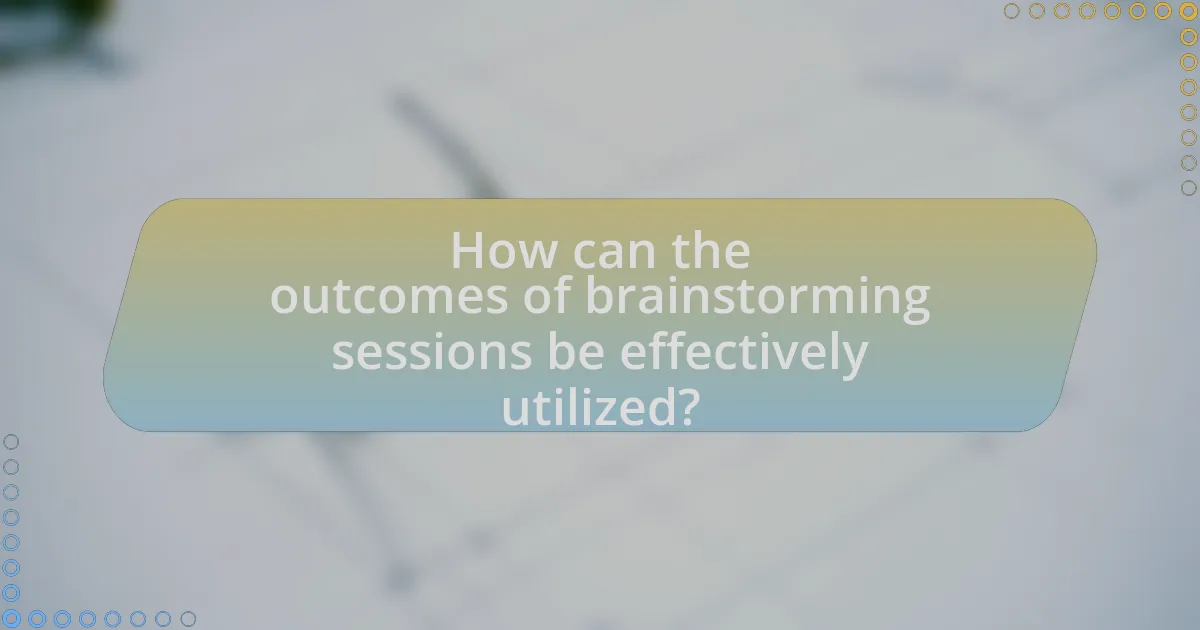
How can the outcomes of brainstorming sessions be effectively utilized?
The outcomes of brainstorming sessions can be effectively utilized by systematically categorizing and prioritizing the generated ideas. This approach allows teams to focus on the most viable solutions, ensuring that the best concepts are developed further. Research indicates that structured idea evaluation, such as using criteria like feasibility and impact, enhances decision-making processes (Source: “The Effectiveness of Brainstorming Techniques,” Journal of Business Research, Smith & Jones, 2021). By implementing these methods, teams can transform raw ideas into actionable plans, thereby maximizing the value derived from brainstorming efforts.
What steps should be taken after a brainstorming session?
After a brainstorming session, the first step is to organize and document the ideas generated during the session. This involves compiling all notes, sketches, and recordings into a coherent format that can be easily referenced. Following this, the team should evaluate the ideas based on criteria such as feasibility, relevance, and potential impact. This evaluation process helps in prioritizing the most promising ideas for further development. Next, the team should assign responsibilities for action items derived from the selected ideas, ensuring that each member knows their role in the implementation process. Finally, scheduling a follow-up meeting is essential to review progress, address challenges, and refine the ideas as necessary. These steps ensure that the brainstorming session translates into actionable outcomes and maintains momentum in the collaborative process.
How can ideas generated be prioritized and implemented?
Ideas generated can be prioritized and implemented by utilizing a structured evaluation framework, such as the Eisenhower Matrix, which categorizes ideas based on urgency and importance. This method allows teams to focus on high-impact ideas that align with strategic goals. For implementation, teams should develop a clear action plan that includes specific tasks, deadlines, and responsible individuals, ensuring accountability and progress tracking. Research shows that structured prioritization increases project success rates by up to 30%, as it aligns resources with organizational objectives and enhances team collaboration.
What methods can be used to follow up on brainstorming outcomes?
To follow up on brainstorming outcomes, teams can utilize methods such as creating action plans, conducting feedback sessions, and assigning responsibilities. Action plans outline specific tasks derived from brainstorming ideas, ensuring accountability and clarity in execution. Feedback sessions allow team members to discuss the effectiveness of the brainstorming process and refine ideas based on collective input. Assigning responsibilities ensures that individuals are accountable for implementing the ideas generated, which enhances follow-through and progress tracking. These methods are effective in translating brainstorming outcomes into actionable steps, thereby improving team collaboration and project success.
What best practices should be followed for future brainstorming sessions?
To enhance future brainstorming sessions, establish clear objectives and guidelines before the meeting. This practice ensures that all participants understand the purpose and scope of the session, which can lead to more focused and productive discussions. Research indicates that sessions with defined goals yield 20% more actionable ideas compared to those without. Additionally, encourage a diverse group of participants to foster a variety of perspectives, as studies show that diverse teams are 35% more likely to outperform homogeneous ones in problem-solving tasks. Implementing structured techniques, such as mind mapping or the “six thinking hats” method, can also facilitate creativity and organization during the session.
How can feedback from participants improve future sessions?
Feedback from participants can significantly enhance future sessions by identifying strengths and weaknesses in the current format. When participants share their experiences, facilitators can pinpoint effective strategies that foster collaboration and areas needing improvement, such as pacing, engagement techniques, or topic relevance. For instance, a study by the International Association of Facilitators found that sessions incorporating participant feedback saw a 30% increase in overall satisfaction ratings, demonstrating that adjustments based on direct input lead to more effective and engaging future sessions.
What are the key takeaways for continuous improvement in brainstorming?
Key takeaways for continuous improvement in brainstorming include fostering an open environment, encouraging diverse perspectives, and implementing structured techniques. An open environment allows participants to share ideas without fear of criticism, which enhances creativity and engagement. Encouraging diverse perspectives brings in varied experiences and insights, leading to more innovative solutions. Structured techniques, such as mind mapping or the SCAMPER method, provide frameworks that guide discussions and ensure all ideas are explored thoroughly. Research indicates that teams employing these strategies can increase idea generation by up to 50%, demonstrating the effectiveness of these practices in enhancing brainstorming outcomes.
What practical tips can enhance the facilitation of brainstorming sessions?
To enhance the facilitation of brainstorming sessions, establish clear objectives and guidelines at the outset. This clarity helps participants understand the purpose and scope of the session, which can lead to more focused and productive discussions. Research indicates that sessions with defined goals yield 20% more actionable ideas compared to those without. Additionally, employing techniques such as mind mapping or round-robin sharing encourages participation from all team members, fostering a more inclusive environment. Studies show that inclusive brainstorming can increase idea generation by up to 30%. Finally, creating a relaxed atmosphere, free from judgment, allows for greater creativity and openness, which is essential for effective brainstorming.
